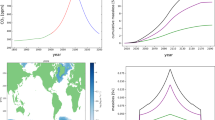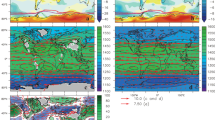Abstract
Model studies point to enhanced warming and to increased freshwater fluxes to high northern latitudes in response to global warming. In order to address possible feedbacks in the ice-ocean system in response to such changes, the combined effect of increased freshwater input to the Arctic Ocean and Arctic warming—the latter manifested as a gradual melting of the Arctic sea ice—is examined using a 3-D isopycnic coordinate ocean general circulation model. A suite of three idealized experiments is carried out: one control integration, one integration with a doubling of the modern Arctic river runoff, and a third more extreme case, where the river runoff is five times the modern value. In the two freshwater cases, the sea ice thickness is reduced by 1.5–2 m in the central Arctic Ocean over a 50-year period. The modelled ocean response is qualitatively the same for both perturbation experiments: freshwater propagates into the Atlantic Ocean and the Nordic Seas, leading to an initial weakening of the North Atlantic Drift. Furthermore, changes in the geostrophic currents in the central Arctic and melting of the Arctic sea ice lead to an intensified Beaufort Gyre, which in turn increases the southward volume transport through the Canadian Archipelago. To compensate for this southward transport of mass, more warm and saline Atlantic water is carried northward with the North Atlantic Drift. It is found that the increased transport of salt into the northern North Atlantic and the Nordic Seas tends to counteract the impact of the increased freshwater originating from the Arctic, leading to a stabilization of the North Atlantic Drift.
Similar content being viewed by others
References
Aagaard, K., and E. C. Carmack, 1989: The role of sea ice and other fresh water in the Arctic circulation.J. Geophys. Res.,94, 14485–14498.
Anderson, L. G., and Coauthors, 1994: Water masses and circulation in the Eurasian Basin: Results from the Oden 91 expedition.J. Geophys. Res.,99, 3273–3283.
Arakawa, A., and V. R. Lamb, 1977: Computational design of the basic processes of the UCLA General Circulation Model.Methods Comput. Phys. 100, 174–265.
Aukrust, T., and J. M. Oberhuber, 1995: Modelling of the Greenland, Iceland and Norwegian Seas with a coupled sea ice-mixed layer-isopycnal ocean model.J Geophys. Res.,100, 4771–4789.
Bleck, R., C. Rooth, D. Hu, and L. T. Smith, 1992: Salinity-driven thermocline transients in a wind- and thermohaline-forced isopycnic coordinate model of the North Atlantic.J. Phys. Oceanogr.,22, 1486–1505.
Broecker, W. S., W. S. Bond, G. McManus, M. Klas, and E. Clark, 1992: Origin of the North Atlantic’s Heinrich events.Climate Dyn.,6, 265–273.
Carmack, E. C., 1990: Large-scale physical oceanography of polar oceans.Polar Oceanography, Part A: Physical Science, W. O. Smith, Ed., Academic Press, Inc., San Diego, California, 171–222.
Clark, P. U., N. G. Pisias, T. F. Stocker, and A. J. Weaver, 2002: The role of the thermohaline circulation in abrupt climate change.Nature,415, 863–869.
Cooper, C., and C. Gordon, 2002: North Atlantic Ocean decadal variability in the Hadley Centre Coupled Model.J Climate,15, 45–72.
Cubasch, U., and Coauthors, 2001: Projections of future climate change.Climate Change 2001: The Scientific Basis. Contribution of Working Group I to the Third Assesment Report of the Intergovernmental Panel on Climate Change, J. T. Houghton et al., Eds. Cambridge University Press, New York, 526–582.
Drange, H., and K. Simonsen, 1996: Formulation of AirSea Fluxes in the ESOP2 Version of MICOM. Tech. Rep. 125, Nansen Environmantal and Remote Sensing Center, Bergen, 24pp.
Dümenil, L. K. Isele, H. J. Liebscher, U. Schröder, and K. Wilke, 1993: Discharge data from 50 selected rivers for GCM validation. Tech. Rep. 100, Max Planck Institute, Hamburg.
ECMWF, 1988:ECMWF Forecast Model. Physical Parametrization. Research Manual 3, 2nd Edition.
Fairbanks, R. G., 1989: A 17000-year glacio-eustatic sea level record: Influence of glacial melting rates on the Younger Dryas event and deep-ocean circulation.Nature,342, 637–642.
Furevik, T., M. Bentsen, H. Drange, I. K. T. Kindem, N. G. Kvamstø, and A. Sorteberg, 2003: Description and validation of the Bergen Climate Model: ARPEGE coupled with MICOM.Climate Dyn.,21, 27–51, doi:10.1007/s00382-003-0317-5.
Gent, P. R., 2001: Will the North Atlantic Ocean thermohaline circulation weaken during the 21st century?Geophys. Res. Lett.,28, 1023–1026.
Goosse, H., T. Fichefet, and J. H. Campin, 1997: The effects of the water flow through the Canadian Archipelago in a global ice-ocean model.Geophys. Res. Lett.,24, 1507–1510.
Hansen, B., and S. Østerhus, 2000: North Atlantic-Nordic Seas exchanges.Prog of Oceanography,45, 109–208.
Hansen, B., S. A. Malmberg, O. H. Saelen, and S. Osterhus, 1998: Measurment of flow north of the Faroe Islands June 1986. ICES Cooperative Research Report No. 225, The ICES NANSEN Project, Copenhagen, 83–95.
Harder, M. 1996: Dynamik, Rauhigkeit und Alter des Meereises in der Arktis. Ph. D. Dissertation, Alfred-Wegner-Institut für Polar- und Meeresforschung, Bremerhaven, 124pp.
Hibler, W. D., 1979: A dynamic thermodynamic sea ice model.J. Phys. Oceanogr.,9, 815–846.
Hopkins, T. S., 1991: The GIN Sea-A synthesis of its physical oceanography and literature review 1972–1985.Earth Science Reviews,30, 175–318.
Huschke, R. E., 1969: Arctic cloud statistics from air calibrated surface weather observations. Memo. RM-6173-PR, Rand. Corporation, Santa Monica, Calif, 79pp.
Johannessen, O. M., and M. Miles, 2000: Arctic sea ice and climate change—Will the ice disappear in this century?Science Prog.,83(3), 209–222.
Johannessen, O. M., E. V. Shalina, and M. Miles, 1999: Satellite evidence for an Arctic sea ice cover in transformation.Science,286(5446), 1937–1939.
Jones, G. A., and L. D. Keigwin, 1988: Evidence from Fram Strait (78°N) for early deglaciation.Nature,336, 56–59.
Kreyscher, M., M. Harder, P. Lemke, and G. M. Flato, 2000: Results of the Sea Ice Model Intercomparison Project: Evaluation of sea-ice rheology schemes for use in climate simulations.J. Geophys. Res.,105, 11299–11320.
Latif, M., 1998: Dynamics of interdecadal variability in coupled ocean-atmosphere models.J. Climate,11, 602–624.
Latif, M., E. Roeckner, U. Mikolajewicz, and R. Voss, 2000: Tropical stabilization of the thermohaline circulation in a greenhouse warming simulation.J. Climate,13, 1809–1813.
Legates, D. R., and C. J. Willmott, 1990: Mean seasonal and spatial variability in gauge-corrected, global precipitation.Int. J. Climatol.,10, 111–127.
Lehman, S. J., and L. D. Keigwin, 1992: Sudden changes in North Atlantic circulation during the last deglaciation.Nature,356, 757–762.
Levitus, S., and T. P. Boyer, 1994:World Ocean Atlas 1994. Volume 4: Temperature. NOAA Atlas NESDIS 4, Washington, D. C., 117pp.
Levitus, S., R. Burgett, and T. P. Boyer, 1994:World Ocean Atlas 1994. Volume 3: Salinity, NOAA Atlas NESDIS 3, Washington, D. C., 99pp.
Manabe, S., and R. J. Stouffer, 1994: Multiple-century response of a coupled ocean-atmosphere model to an increase of atmospheric carbon dioxcide.J. Climate,7, 5–23.
Maykut, G. A., 1978: Energy exchange over young sea ice in the Central Arctic.J. Geophys Res.,83, 3646–3658.
Millero, F. J., 1978: Freezing point of seawater. Eighth Report on the Joint Panel on Oceanographic Tables and Standards, Annex 6, Paris, UNESCO Tech. Pap. Mar. Sci., No. 28, 29–31.
Mitchell, J. F. B., T. C. Johns, J. M. Gregory, and S. F. B. Tett, 1995: Climate response to increasing levels of greenhouse gases and sulphate aerosols.Nature,376, 501–504.
Mosby, H., 1962: Water, salt and heat balance of the North Polar Sea and the Norwegian Sea.Geophys Norv.,24(11), 289–313.
NOAA, 1988: Data Announcement 88-MGG-02, Digital relief of the surface of the Earth. Tech. Rep., NOAA, National Geophysical Data Center, Boulder, CO, U.S.A.
Oberhuber, J. M., 1988: An atlas based on the ‘COADS’ data set: The budgets of heat, buoyancy and turbulent kinetic energy at the surface of the global ocean. Tech. Rep. Max Planck Institute, Hamburg, 15pp.
Otterå, O. H., H. Drange, M. Bentsen, N. C. Kvamstø, and D. Jiang, 2003: The sensitivity of the present day Atlantic meridional overturning circulation to freshwater forcing.Geophys. Res. Lett.,30(17), 1898, doi:101029/2003GL017578.
Peltier, W. R., 1994: Ice age paleotopography.Science,265, 195–201.
Peterson, B. J., R. M. Holmes, J. M. McClelland, C. J. Vorosmarty, R. B. Lammers, A. I. Shiklomanov, I. A. Shiklomanov, and S. Rahmstorf, 2002: Increasing river discharge to the Arctic Ocean.Science,298(5601), 2171–2173.
Prange, M., and R. Gerdes, 1999: Influence of Arctic river runoff on the circulation in the Arctic Ocean, the Nordic Seas and the North Atlantic. ICES ASC Council Meeting L/11, 5pp
Rahmstorf, S., 1995: Climate drift in an ocean model coupled to a simple, perfectly matched atmosphere.Climate Dyn.,11, 447–458.
Rahmstorf, S., 1999: Long-term global warming scenarios computed with an efficient coupled climate model.Climatic Change,43, 353–367.
Räaisöanen, J., 2001: CO2-induced climate change in the Arctic area in the CMIP2 experiments.SWECLIM Newsletter,11, 23–28.
Roach, A. T., Aagaard, K., C. H. Pease, S. A. Salo, T. Weingartner, V. Pavlov, and M. Kulakov, 1995: Direct measurements of transport and water properties through the Bering Strait.J. Geophys. Res.,100, 18443–18457.
Roullet, G., and G. Madec, 2000: Salt conservation, free surface, and varying levels: a new formulation for ocean general circulation models.J. Geophys. Res.,105, 23927–23942.
Rudels, B., L. G. Anderson, and E. P. Jones, 1996: Formation and evolution of the surface mixed layer and halocline in the Arctic Ocean.J. Geophys. Res.,101, 8807–8821.
Schiller, A., U. Mikolajewicz, and R. Voss, 1997: The stability of the North Atlantic thermohaline circulation in a coupled ocean-atmosphere general circulation model.Climate Dyn.,13, 325–347.
Semtner, A. J., 1987: A numerical study of the sea ice and ocean circulation in the Arctic.J. Phys. Oceanogr.,17, 1077–1099.
Simonsen, K., 1996: Heatbudgets and freshwater forcing of the Nordic Seas and the Artic Ocean. Ph. D. Dissertation, Nansen Env. and Remote Sensing Center.
Simonsen, K., and P. M. Haugan, 1996: Heat budgets of the Arctic Mediterranean and sea surface heat flux parametrizations for the Nordic Seas.J. Geophys. Res.,101, 6553–6576.
Simonsen, K., and H. Drange, 1997: Surface forcing and initialization of the ESOP2 version of MICOM. Tech. Rep. 116, Nansen Environmantal and Remote Sensing Center, Bergen, 28pp.
Steele, M., D. Thomas, and D. Rorhrock, 1996: A simple model study of the Arctic Ocean freshwater balance, 1979–1985.J. Geophys. Res.,101, 20833–20848.
Sun, S., and R. Bleck, 2001: Atlantic Thermohaline Circulation and its Response to Increasing CO2 in a Coupled Atmosphere-Ocean Model.Geophys. Res. Lett. 28, 4223–4226.
Thompson, D. W. J., and J. M. Wallace, 1998: The Arctic Oscillation signature in the wintertime geopotential height and temperature fields.Geophys. Res. Lett. 25, 1297–1300.
Timmermann, A., M. Latif, R. Voss, and A Grötzner, 1998: Northern Hemispheric interdecadal variability: A coupled air-sea mode.J. Climate,11, 1906–1931.
Vellinga, M., and R. A. Wood, 2002: Global climatic impacts of a collapse of the Atlantic thermohaline circulation.Climatic Change,54, 251–267.
Vinnikov, K. Y., and Coauthors, 1999: Global warming and Northern Hemisphere ice extent.Science,286, 1934–1937.
Walsh, J. E., and C. M. Johnson, 1979: An analysis of Arctic ice fluctuations, 1953–77.J. Geophys. Res.,9, 580–591.
Walsh, J. E., W. L. Chapman, and T. L. Shy, 1996: Recent decrease of sea level pressure in the Central Arctic.J Climate,9, 480–486.
Author information
Authors and Affiliations
Corresponding author
Rights and permissions
About this article
Cite this article
Otterå, O.H., Drange, H. A possible feedback mechanism involving the Arctic freshwater, the Arctic sea ice, and the North Atlantic Drift. Adv. Atmos. Sci. 21, 784–801 (2004). https://doi.org/10.1007/BF02916375
Received:
Revised:
Issue Date:
DOI: https://doi.org/10.1007/BF02916375




